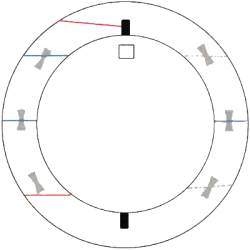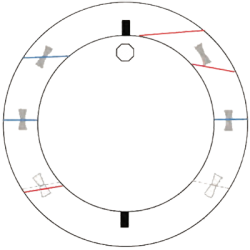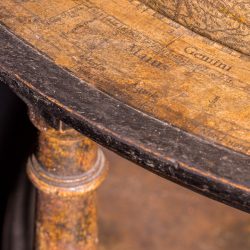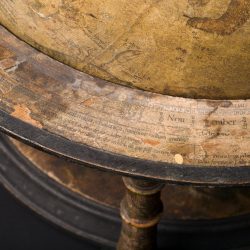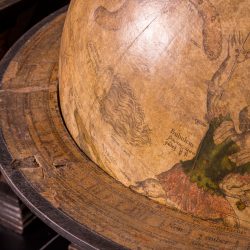Horizon rings
The horizon ring, 5.8 cm wide and 2.9 cm thick, is made of several dovetailed pieces of oak. The outer diameter of the ring is 54.2 cm and the inner diameter 42.2 cm.
- Terrestrial globe
- Celestial globe
Assemblage and pieces comprising the horizon ring as seen from the left of the terrestrial globe and from the right of the celestial globe. In grey, the dovetails; in blue, the joints between the pieces; dotted, dovetails or assemblages that cannot be seen but probably exist; in red, crack splits or cracks. The black sections, representing the notches for the meridian circle and the compasses, are shown schematically as a square and an octagon. The various pieces and joints are not totally symmetrical. © SIK|ISEA
- Horizon ring of the terrestrial globe
- Horizon ring of the terrestrial globe
- Horizon ring of the celestial globe
- Horizon ring of the celestial globe
Two notches cut deeply into the wood hold the copper meridian in place.
Between the paper layer and the wood there is a thick layer of charged adhesive (or a thin preparatory layer). The surface of the paper is partly coated with natural-resin varnish. This does not cover all the horizon ring: on about 1.5 cm from the inside (the part with the inscriptions of the horoscopes and days), a band is unvarnished. The limit of the varnish is not very precise, suggesting that it is not an original varnish.
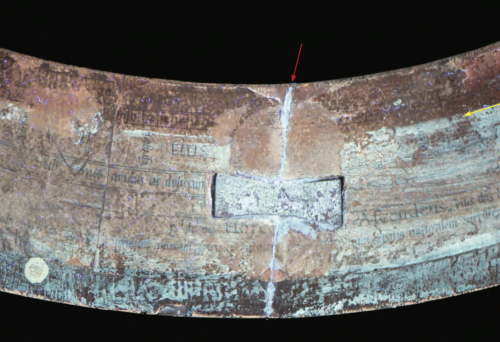
Close-up photo of the horizon ring of the celestial globe under UV fluorescence prior to restoration. The varnish fluoresces strongly whereas the unvarnished band towards the inside of the ring (above the yellow arrow) does not fluoresce. We can see that the varnish is very worn. The glue spilling over the joint from a previous restoration (red arrow) is also enhanced under UV fluorescence. © SIK|ISEA
Find out more
- Les globes de Mercator de l’Université de Lausanne. Observations matérielles. Constat d’état. Rapport de conservation-restauration : workshop and laboratory of the Swiss Institute for Art Research SIK|ISEA, Ref. No. 141110 0002: 01/02, October 2015, Margaux Genton, Zurich.
- View the horizon ring of the terrestrial globe in full : UNIL’s School of Forensic Science reconstructed the horizon ring from photos taken for the 3D digitisation. NB: the PNG file is very large (80 MB); the original version can also be downloaded [PSB, 1,69 Go]
